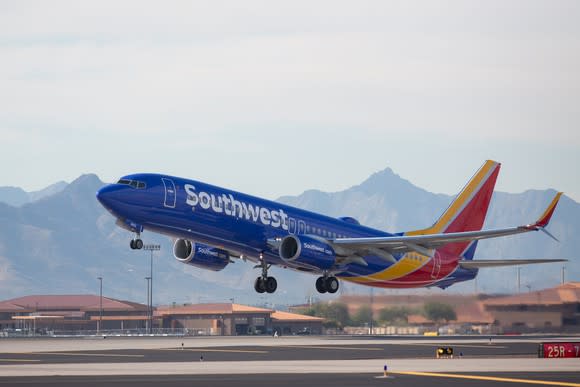Southwest Airlines Confirms Its International Ambitions
Southwest Airlines' (NYSE: LUV) plans to start flying to Hawaii in late 2018 or early 2019 have attracted a lot of media buzz. The carrier's steady growth in international markets has received substantially less attention.
However, at Southwest's recent annual meeting, CEO Gary Kelly confirmed that the company still is eager to grow in international markets. This suggests that Southwest Airlines will continue to spread its growth around in the coming years, rather than just expanding in Hawaii -- which is good news for local leader Hawaiian Holdings (NASDAQ: HA).
International expansion still on tap
In his remarks at the annual meeting, Kelly noted that Southwest Airlines flies to just 14 international destinations today, spread across the Caribbean, Mexico, and Central America. That compares to 86 domestic cities. Southwest currently deploys a mere 4% of its capacity outside the U.S., whereas many of its competitors get 25% or more of their revenue from international routes.
Southwest Airlines probably will always have a lower mix of international routes than its main rivals, but it's clearly just scratching the surface of its potential today. Kelly indicated that Southwest could potentially add 50 more cities to its route map over time -- primarily international markets. This will include destinations in South America, a region that Southwest hasn't even begun to penetrate.

Southwest Airlines CEO Gary Kelly sees a lot of room for international growth. Image source: Southwest Airlines.
Obviously, Southwest doesn't expect to capture this entire opportunity in a year or even a few years. But over the next couple of decades, management sees room to deploy hundreds of planes in these new markets, which would translate to, perhaps, 10 extra planes per year.
Multiple growth priorities
During his recent remarks, Kelly described Hawaii as "a major focus for Southwest in 2019 as far as our fleet growth is concerned." That said, it's notable that he also highlighted international expansion opportunities -- and Southwest's continuing growth in the continental U.S., for that matter.
Thus, the overall picture that Southwest Airlines' management is painting is one of balanced growth in multiple geographic regions. Investors' fears that Southwest Airlines will swamp the West Coast-Hawaii market with unneeded capacity -- devastating rivals like Hawaiian Airlines and Alaska Air -- may be overstated.
Southwest Airlines also seems committed to maintaining a modest mid-single-digit growth rate (at most). The carrier is scheduled to take delivery of an average of nearly 40 aircraft annually between 2018 and 2022, but many of these planes will be used to replace older planes that were retired last year or will be retired in the near future. Annual fleet growth is likely to be in the 3% to 4% range after 2018.
The Hawaii market can handle this kind of growth
Southwest Airlines may deploy about half of its 2019 fleet growth on West Coast-Hawaii routes, given that it has identified this market as its top near-term growth priority. Still, depending on Southwest's exact aircraft-retirement schedule, this only works out to about a dozen daily round-trip flights to Hawaii.
That amount of growth wouldn't be devastating to Hawaiian Airlines (or its rivals in the West Coast-Hawaii market). It would represent a roughly 9% increase in industry capacity between the western U.S. and Hawaii. For comparison, the West Coast-Hawaii market is currently absorbing double-digit capacity growth without much pressure on fares.
If Southwest Airlines were to continue deploying half of its growth in Hawaii beyond 2019 -- including its planned move into the interisland market -- it could create a supply-demand imbalance, hurting Hawaiian Airlines.
However, that's not likely to happen. Southwest will need to reserve a substantial chunk of its fleet growth to meet rising demand in its existing domestic markets. Its international ambitions will require most of its remaining planned growth. This will naturally lead to a slower rate of growth in Hawaii than many investors and analysts seem to expect -- giving Hawaiian Airlines plenty of time to adjust.
More From The Motley Fool
Adam Levine-Weinberg owns shares of Alaska Air Group and Hawaiian Holdings. The Motley Fool has no position in any of the stocks mentioned. The Motley Fool has a disclosure policy.

 Yahoo Finance
Yahoo Finance 